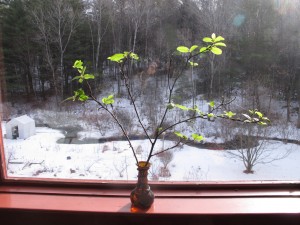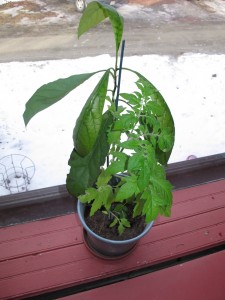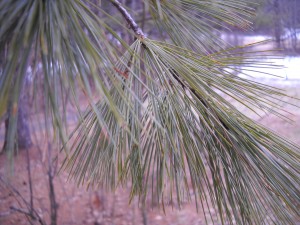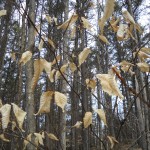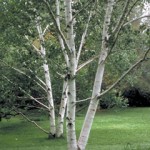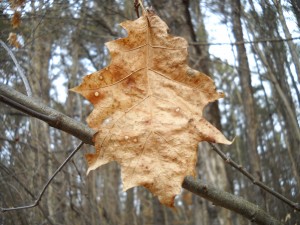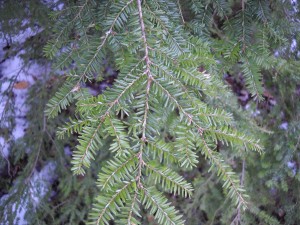Getting through the Doldrums
When pruning a Merrill magnolia last November, I brought home a few stems that had nice fat flower buds and put them in a vase of water. I put them in a south-facing window and pretty much forgot about them. From time to time I admired the smooth gray bark and handsome branching patterns. But then in the first week of January, those stems developed lovely green leaves! And the flower buds are swelling and look as if they might bloom, too – but even if they don’t, my spirits are lifted by seeing some green leaves.
Forcing blossoms of tree branches (making them bloom early indoors) is normally something I do in March, when I am pruning apple trees. I always bring in some branches and enjoy both the leaves and flowers of stems I have cut. At that time of year the trees are already “thinking” about opening up their buds, and it only takes a week or two for them to open up on a sunny windowsill.
But this year, I am going to cut apples, forsythia, lilacs and other spring-blooming trees and shrubs starting now. Each week I shall snip a few branches and experiment with forcing. I have never tried forcing lilacs, for example, and since they are mid-to late-spring bloomers, I would normally hold off until nearer the time that they normally break dormancy –perhaps in April. But why not try now? I have read that one can encourage branches to break dormancy by submerging them entirely in a bathtub of water and will give that a try.
When you select branches for forcing, be sure to pick some that have flower buds. Flower buds are generally fatter than leaf buds. On apple trees, flowers are generally found on fruit spurs. These are 2- or 3-inch long stems that end in fat buds. The buds contain both leaf and flower buds. For many varieties, fruit spurs must be more than a year old in order to produce flowers (and hence fruit). Last year’s water sprouts (vertical whips) on apples will produce leaves but not flowers.
Almost any tree can be forced, but many do not have flowers that are colorful, so we often ignore them. Do you know what a maple or poplar blossom looks like? Their small green flowers are not much appreciated – and I have never cut them to put in a vase. You certainly recognize pussy willows as signs of spring, but do you think of those furry fellows as flowers? They are flowers, and can give me as much pleasure in February as my roses will later on.
For best results, cut stems of trees according to their natural schedule. That means picking early bloomers now, and later bloomers in February and March. Here is a rough schedule: In January cut forsythia , willows and poplars. In early February cut red maples, alder, quince, birch and cherries. Later in February try rhododendrons, azaleas and pussy willows. Then in March try cutting branches of hawthorns, shrub honeysuckles, apples, crabapples, mockorange, lilacs, and spirea.
Elsewhere in the house I was recently surprised by a tomato plant that appeared in a pot where I have an avocado growing. The avocado was one that I dug out of the compost pile last fall – along with a tomato seed, apparently. Most grocery store avocados do not have viable seeds, as the seeds need to be fresh (picked within 3 weeks of planting) in order to grow.
I remember as a boy suspending an avocado seed in a glass of water by toothpicks. It sent roots down into the glass, and then sent up a stem. I planted the seedling in a pot, creating a nice houseplant with glossy green leaves. But since the avocado industry now stores and sells avocados all year, the seeds are usually too old to grow. But I guess last summer I threw a few fresh avocado seeds into the compost because three seeds grew!
But what about that orphan tomato growing with my avocado? I am going to give it every benefit. I have heard about people who have gotten tomatoes to bloom and produce fruit indoors in winter, though I have never done it. To help mine along I have hung a light over it in the window where it is growing. I am using an LED light that uses very little energy and produces a lot of light from its 45 little LED bulbs. It’s produced by Sunshine Systems (www.sunshine-systems.com) and uses just 28 watts of power while providing the light of a 250 watt hps lamp.
I realize that my tomato might not produce tasty fruit even if I get some. It all depends on the seed: it will be fine if it came from an heirloom tomato (which is mostly what I grow), but if it’s from a hybrid tomato plant, it might produce an undesirable fruit. Hybrids most often revert to the parent types, which may not be tasty. Still … it’s winter, and I’m game to try almost anything to feel like a gardener.
Henry Homeyer is the author of 4 gardening books and lectures on gardening throughout New England. He can be reached at henry.homeyer@comcast.net.
Identifying Trees in Winter
Before we launch into this week’s article…
Gardening Classes with Henry
Lebanon College: Gardening: A Practical Workshop. Garden writer Henry Homeyer will teach you the basics of organic vegetable and flower gardening. From garden design to seed-starting , planting, watering, weeding, mulching, and harvesting, this course will give each student practical knowledge of gardening. Tuesday nights from 6:30-8:30 for 5 weeks, April 3-May 2.Contact Lebanon College to reserve a spot for this5-part workshop www.lebanoncollege.edu or call 603-448-2445.
AVA Gallery, Lebanon. Henry will teach 3 classes at AVA Gallery this spring. You may sign up for one or all of these workshops:
Sculpting the Living Landscape: Starting Flowers from Seed
April 9; Monday, 6:30–8:30pm; One 2-hour class
Sculpting the Living Landscape: Perfect Perennials for the Upper Valley Garden
April 23; Monday, 6:30–8:30pm; One 2-hour class
Sculpting the Living Landscape: Organic Techniques for Enriching Soil and Managing Pests
May 7; Monday, 6:30–8:30pm; One 2-hour class
For more information go to www.avagallery.org or call 603-448-3117.
Identifying Trees in Winter
Most of us enjoying knowing the names of our acquaintances – including trees. It’s tougher to identify trees in winter because most have no leaves, which is how we generally recognize trees. But by observing overall shape, bark, branching patterns, buds and the presence or absence of leaves, you should be able to pick out several common trees quite easily.
The trees discussed here include 5 that keep all or some of their leaves; the rest lose all their leaves. The first group includes white pine, Canadian hemlock and spruce, all of which have green needles – their form of leaves. Oaks and beeches are broad-leafed trees that hold all or some of their leaves, though the leaves are dead and brown. Young trees hold more of the dead leaves than more mature ones.
White pine (Pinus strobus) has clusters of 5 soft needles, each about 3 inches long. Branches grow in whorls off the trunk; each year the tree grows just one new set of branches, so you can see how fast they grow by observing the distance between whorls on the main trunk. From a distance you can see clumps of needles pointing up near the top of the tree.
Canadian hemlock (Tsuga canadensis) has short, flat needles that feel soft to the touch and that have a white line on the underneath side of each. It is one of the few trees in the woods that can grow in deep shade – as well as full sun.
There are several kinds of spruce (Picea spp.), but all share this characteristic, which will separate them from hemlock trees: turn over a branch and observe the color of the leaves. If the needles on the top side and the bottom of the bough are the same color, it is a spruce. Spruce needles are pointy and sharp. Spruce hold more snow on their branches than other evergreens, too, often leaving little snow beneath the tree.
American beech (Fagus grandifolia) is most easily identified by its smooth gray bark; some older trees have bark that is scarred by a fungus. Their buds are up to an inch long with sharp pointy ends; they are shaped a bit like little cigars. Young beech trees hold lots of leaves but the older ones tend to lose most. Leaves are 2-5 inches long, oval, and have serrated edges.
Oaks ( Quercus spp.) also hold at least a few leaves. The leaves are lobed, often ending in a sharp point. There are a few oaks that have different shaped leaves, but you probably won’t come across one. Acorns are a dead giveaway, too, though most acorns have fallen by now.
Buds and small (side) branches are either opposite each other on a branch or they alternate – one here, one
farther along on the other side. Only 3 common trees have opposite branching: the maples (many species), ash (4 species), and horse chestnut. There are several kinds of shrubs that have opposite branching, including viburnums, most dogwoods, lilacs and honeysuckles. Don’t be deceived by the fact that often twigs are broken off, so that the branching pattern may not appear at first glance to be opposite.
Of the many kinds of maples (Acer spp.), sugar and red maples are common in most woods. At the end of each branch you will see 3 buds: a terminal bud and a bud on each side of it. The buds are sharply pointed on sugar maples, less so on red maples. Red maple buds get redder as the winter progresses. Get to know a few big old sugar maples during sugaring season, and you will soon recognize the color of bark and the overall shape. Red maples tend to have branches that spread less than sugar maples, and they can live in wet places (but sugar maples rarely do).
White ash (Fraxinus americanus) also has opposite buds, but they are much more rounded than those on maples. The key characteristic for me is the bark, which is furrowed into diamond shaped areas on mature trees. You will also see that small branches on an ash are also much less delicate than those on a maple. Looking up at branches, you will see that they have lots of lumps and bumps near their tips.
White or paper birch (Betula papyrifera) is one of the best known of our native trees: it has bright, white bark that tends to peel as the tree gets bigger. Other birches include gray and yellow birches. The former has dirty gray bark; the latter has finely peeling silvery or golden bark. All have horizontal marks on the bark called lenticels. Lenticels allow air into the inner growing layer of the tree. Their twigs are fine, and may have catkins (narrow pollen-producing structures 2 inches long or so) towards the top of the tree.
One of our most common trees is the poplar (Populus deltoides). Poplars are fast growing, short-lived trees that jump up anywhere, even in poor soil along roadsides. They tolerate wet or dry locations and are immune to road salt. I recognize them from the color of the bark – it is greenish to putty-colored, particularly up high. It is often an irregular-shaped tree that is considerably taller than wide.
So clip this article and take a walk in the woods. See what you can identify. And bring along a tree I.D. book to help. I like A Guide to Nature in Winter by Donald Stokes, as it has information about everything you can see outdoors in winter, not just the trees.
Henry is the author of four books and writes a self-syndicated weekly column for 12 newspapers throughout New England. You can contact Henry by e-mail at henry.homeyer@comcast.net.



